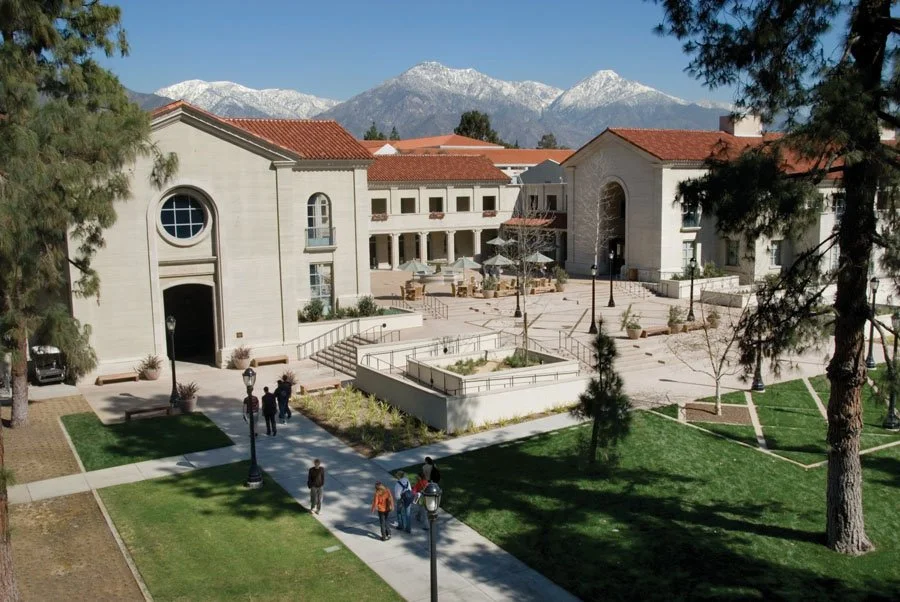So, you’re wondering about The Claremont Colleges.
Maybe they keep coming up in your college search, but you’ve never heard of them. Or maybe you have heard of them, but you’re unsure about going to a small college. But are they small colleges, or is it really one big college? Is Claremont McKenna the same thing as Claremont College? And what on earth is a Consortium?
Don’t worry, this Pitzer alumna (and former admissions officer!) is here to break it all down for you.
Let’s start with the history and unique elements of each school:
Pomona College: Bringing New England to the West
It all started when a group of congregationalists envisioned a “New England-type” liberal arts college on the West Coast, establishing Pomona College in 1887. It boasts a broad curriculum, with majors in the humanities, social sciences, and natural sciences. Pomona also has everything you might expect from one of the nation’s finest liberal arts colleges, including exceptional faculty, an intimate learning environment, and among 50 majors to choose from.
All was well until 1923, when Pomona College president, James Blaisdell, grappled with a problem: the college’s popularity. Unwilling to jeopardize the small student-to-teacher ratio, the president advised the college to mirror Oxford and Cambridge and establish a consortium of differentiated small colleges. And voila! The Claremont Colleges were born.
Scripps College: Empowering Women in All Disciplines
The 1920s kicked off with the passage of the 19th Amendment, which gave White women in the United States the right to vote. This was also a period of time when women were joining the workforce in increasing numbers and enjoying more freedom in their personal lives. American journalist and philanthropist Ellen Browning Scripps founded Scripps College in 1927 to provide women access to a higher education.
Strong in the humanities and the arts, Scripps’ core curriculum encourages students to develop their communication and critical thinking skills to deepen their understanding of complex topics through discussion, debate, and the pursuit of knowledge. But Scripps is not all about humanities; the College awards the highest percentage of STEM degrees of any women’s college in the nation.
Claremont McKenna College: Liberals Arts Meets Leadership
The Servicemen’s Readjustment Act of 1944, more commonly known as the G.I. Bill, provided benefits to some of the returning World War II veterans, including dedicated payments of tuition to attend college. With the influx of soldiers returning from war came the “undergraduate school for men,” in 1947, known today as Claremont McKenna College.
No longer an all-male institution, CMC still echoes its founding commitment of preparing liberal arts-educated business and public leaders. It’s especially popular with students wishing to study social sciences such as economics, public policy, and international relations.
Harvey Mudd College: Scientists and Engineers for Humanity
The 1950s is remembered as the age of the Space Race, a time in which the Soviet Union and the United States used the cosmos as an arena for competition, with each side wanting to prove the superiority of its technology. This made technical education a priority in the US, and thus, Harvey Mudd College was born in 1955.
Today, Harvey Mudd continues to produce engineers, scientists, and mathematicians who also have strong backgrounds in the humanities and social sciences. Students are therefore able to best understand the impact of their work on society. If you love math and science but also don’t want to let go of language and philosophy, Harvey Mudd is the place for you.
Pitzer College: Fighting for Civil Rights and Social Justice
Pitzer College was founded in 1963, during a decade known for sit-ins, freedom rides, and protest marches to fight poverty, segregation, and unemployment. Feminists demanded equal job opportunities, environmentalists demanded legislation to control pollution, and the Civil Rights Movement was born.
Pitzer echoes this era today with its social justice-minded community. Students interested in social responsibility, environmental sustainability, intercultural understanding, student engagement, and interdisciplinary learning will find their home at Pitzer.
The Claremont Colleges Consortium: What It Means and Why It’s Awesome
The Claremont Colleges each have their own distinct, yet shared, campus.
Regardless of which college best meets your academic and community needs, attending any of The Claremont Colleges will give you the benefit of all five.
My favorite part about attending Pitzer was that I could eat at all of the dining halls, enjoying sushi at Scripps on Friday nights and delicious brunches at Pomona on Sundays. I had access to 2,700+ classes, and some semesters, I didn’t have any classes on my home campus at all. In one day, I could study at the two-million-volume shared library, play on an intramural tennis team at Pomona, attend a lecture at Claremont McKenna, meet employers at a career fair at Scripps, then return to my home campus of Pitzer to dance at an alternative music festival. I found my closest friends at Pitzer, but also had access to a diversity of thought all around me.
So perhaps you like having small classes because you get direct access to your professors, but you want the midsize university experience for a more varied social life. Consider applying to one of the Claremont Colleges. With average class sizes around 15 students, but a campus life of over 5,000, you truly get the best of both worlds. And if you’re thinking this system sounds awfully like the factions in the Divergent series, you’re exactly right.







